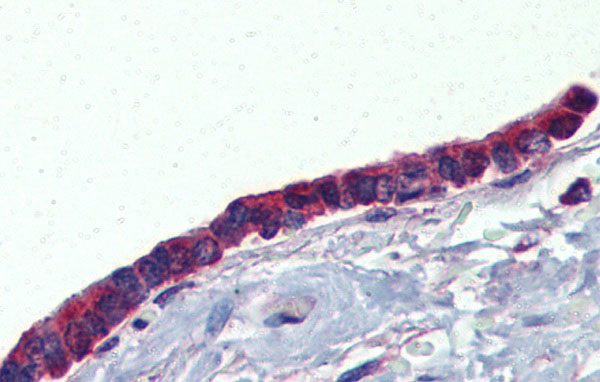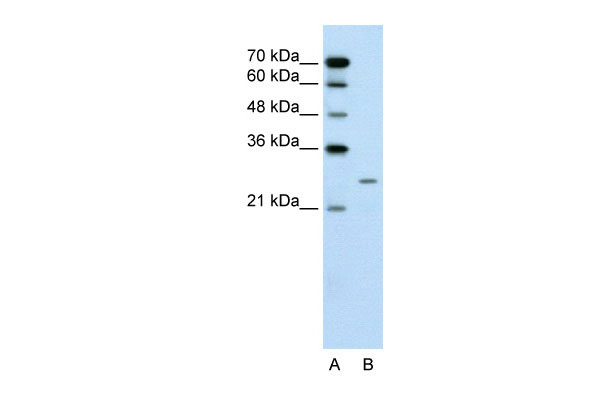PLUNC antibody - middle region
Rabbit Polyclonal Antibody
- 产品详情
- 实验流程
Application
| WB, IHC |
|---|---|
| Primary Accession | Q9NP55 |
| Other Accession | NM_016583, NP_057667 |
| Reactivity | Human, Mouse, Rat, Rabbit, Pig, Goat, Dog, Guinea Pig, Bovine |
| Predicted | Pig |
| Host | Rabbit |
| Clonality | Polyclonal |
| Calculated MW | 26713 Da |
| Gene ID | 51297 |
|---|---|
| Alias Symbol | LUNX, NASG, SPLUNC1, SPURT, bA49G10.5, PLUNC, LPLUNC3 |
| Other Names | BPI fold-containing family A member 1, Lung-specific protein X, Nasopharyngeal carcinoma-related protein, Palate lung and nasal epithelium clone protein, Secretory protein in upper respiratory tracts, Short PLUNC1, SPLUNC1, Tracheal epithelium-enriched protein, Von Ebner protein Hl, BPIFA1, LUNX, NASG, PLUNC, SPLUNC1, SPURT |
| Format | Liquid. Purified antibody supplied in 1x PBS buffer with 0.09% (w/v) sodium azide and 2% sucrose. |
| Reconstitution & Storage | Add 50 ul of distilled water. Final anti-PLUNC antibody concentration is 1 mg/ml in PBS buffer with 2% sucrose. For longer periods of storage, store at 20°C. Avoid repeat freeze-thaw cycles. |
| Precautions | PLUNC antibody - middle region is for research use only and not for use in diagnostic or therapeutic procedures. |
| Name | BPIFA1 |
|---|---|
| Synonyms | LUNX, NASG, PLUNC, SPLUNC1, SPURT |
| Function | Lipid-binding protein which shows high specificity for the surfactant phospholipid dipalmitoylphosphatidylcholine (DPPC) (PubMed:25223608). Plays a role in the innate immune responses of the upper airways (PubMed:23132494, PubMed:23499554). Reduces the surface tension in secretions from airway epithelia and inhibits the formation of biofilm by pathogenic Gram-negative bacteria, such as P.aeruginosa and K.pneumoniae (PubMed:23132494, PubMed:23499554, PubMed:27145151). Negatively regulates proteolytic cleavage of SCNN1G, an event that is required for activation of the epithelial sodium channel (ENaC), and thereby contributes to airway surface liquid homeostasis and proper clearance of mucus (PubMed:24043776, PubMed:24124190). Plays a role in the airway inflammatory response after exposure to irritants (PubMed:11425234). May attract macrophages and neutrophils (PubMed:23132494). |
| Cellular Location | Secreted. Note=Apical side of airway epithelial cells. Detected in airway surface liquid, nasal mucus and sputum |
| Tissue Location | Highly expressed in lung, upper airways and nasopharyngeal regions, including trachea and nasal epithelium (at protein level) (PubMed:11018263, PubMed:11251963, PubMed:11425234, PubMed:12409287, PubMed:26559477). Specifically expressed in the secretory ducts and submucosal glands of tracheobronchial tissues (at protein level) (PubMed:11425234, PubMed:12409287). Also expressed in the eye where it is detected in lacrimal gland, eyelid, conjunctiva and cornea (at protein level) (PubMed:26559477). Specifically localizes to epithelial cell layers in cornea, eyelid (basal epithelium) and conjunctiva (at protein level) (PubMed:26559477). Detected within acinar cells and ducts in the lacrimal and Meibomian glands (at protein level) (PubMed:26559477). In lung, shows highest expression in the trachea and progressive decrease from proximal (bronchial) to distal (bronchiolar) airways (PubMed:12409287). Also expressed in lung cancers and some other types of cancer (PubMed:11251963) |
Research Areas
For Research Use Only. Not For Use In Diagnostic Procedures.
Application Protocols
Provided below are standard protocols that you may find useful for product applications.
REFERENCES
Zhou,H.D.,(2006)Mol.Immunol.43(11),1864-1871ReconstitutionandStorage:Forshorttermuse,storeat2-8Cupto1week.Forlongtermstorage,storeat-20Cinsmallaliquotstopreventfreeze-thawcycles.
终于等到您。ABCEPTA(百远生物)抗体产品。
点击下方“我要评价 ”按钮提交您的反馈信息,您的反馈和评价是我们最宝贵的财富之一,
我们将在1-3个工作日内处理您的反馈信息。
如有疑问,联系:0512-88856768 tech-china@abcepta.com.























 癌症的基本特征包括细胞增殖、血管生成、迁移、凋亡逃避机制和细胞永生等。找到癌症发生过程中这些通路的关键标记物和对应的抗体用于检测至关重要。
癌症的基本特征包括细胞增殖、血管生成、迁移、凋亡逃避机制和细胞永生等。找到癌症发生过程中这些通路的关键标记物和对应的抗体用于检测至关重要。 为您推荐一个泛素化位点预测神器——泛素化分析工具,可以为您的蛋白的泛素化位点作出预测和评分。
为您推荐一个泛素化位点预测神器——泛素化分析工具,可以为您的蛋白的泛素化位点作出预测和评分。 细胞自噬受体图形绘图工具为你的蛋白的细胞受体结合位点作出预测和评分,识别结合到自噬通路中的蛋白是非常重要的,便于让我们理解自噬在正常生理、病理过程中的作用,如发育、细胞分化、神经退化性疾病、压力条件下、感染和癌症。
细胞自噬受体图形绘图工具为你的蛋白的细胞受体结合位点作出预测和评分,识别结合到自噬通路中的蛋白是非常重要的,便于让我们理解自噬在正常生理、病理过程中的作用,如发育、细胞分化、神经退化性疾病、压力条件下、感染和癌症。







